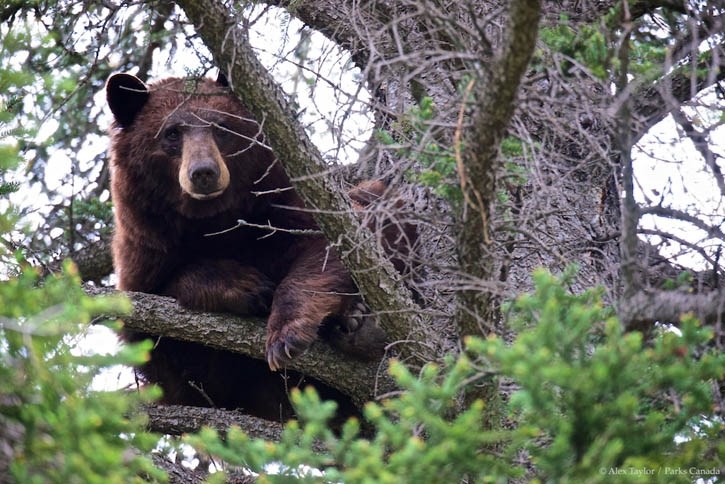BANFF – A mamma black bear and her cub have been destroyed after repeatedly getting into fruit and unsecured garbage this fall in the national park townsite.
In a bid to give the two bears the best chance of survival, they were relocated to a remote area of Banff National Park at the end of September, but beelined back to town where they got into fruit trees and garbage again.
Upon their return, the young-of-year cub and sow were euthanized more than a week ago despite the best efforts of the resource conservation team to discourage the bears' behaviour.
“They continued to access ripe fruit from trees, residential yards, and unsecured garbage within the townsite,” said Kira Tryon, public relations and communications officer for Banff National Park in an email.
“Given that this behaviour was happening in close proximity to residents and the public, the difficult decision was made to euthanize the black bear cub and sow on October 9 and 12, 2022, respectively, to ensure public safety.”
In a growing practice showing a lack of transparency and accountability in Banff National Park, Parks Canada bureaucrats have again refused interview requests with wildlife experts, releasing only a brief statement with little information.
There are no specific details on what led to the eventual euthanization of the two bears, when and how far they returned after being relocated to a remote area, or whereabouts in town the bears were getting into fruit trees and garbage
Unlike on provincial lands, the on-the-ground resource conservation team seldom relocates or kills bears, doing as much as they can to give bears a fighting chance of survival in a human-dominated landscape.
However, the statement from park bureaucrats made no mention of what was specifically done to discourage the bears' behaviour or to get on top of how bears were able to get into attractants left out by people in the first place.
Further, the brief statement provides no information on whether or not Parks Canada is investigating how the bears accessed garbage.
A request for more details was not answered.
Officials with the Town of Banff say the municipality issued a ticket and $150 fine after improperly stored recycling was discovered in a yard near the Beaver Street incident on Oct. 9.
"The Town is investigating properties for wildlife attractants in response to a subsequent bear encounter that Parks Canada responded to in the area of Wolverine and Otter streets," said Jason Darrah, director of communications for the Town of Banff.
"Again, this is being investigated and any fines would be levied related to the Banff Community Standards Bylaw, Section 6, related to fruit in a yard as animal attractants," he added.
"Although Parks Canada did not report specific wildlife attractants directly causing the bears to be in town, in each case our Municipal Enforcement officers are able to inspect the areas and any attractants observed can warrant a ticket for non-compliance."
The mamma black bear and her cub were initially relocated to a remote area of the national park after getting access to a food reward in the industrial compound on Sept. 24 and 25.
Parks Canada would not say what that reward was.
At the time, a Parks Canada statement indicated that hazing was no longer an effective approach.
Parks Canada initially said the bear family had been frequenting other high use areas in the Banff townsite, feeding on natural foods.
The recent statement from Parks Canada is committed to ensuring public safety, protecting wildlife, and implementing proactive measures to reduce conflicts between people and wildlife – but it does not say how it does that.
“Parks Canada works hard to ensure safe and positive human-wildlife coexistence, including taking a phased and adaptive management approach to managing wildlife in the national park, such as monitoring wildlife movement, removing wildlife attractants, and performing hazing or aversive conditioning,” said Tryon in the statement.
In neighbouring Canmore, a mother black bear and two cubs were killed by Alberta Fish and Wildlife officers for public safety reasons on Oct. 3 after repeatedly feeding in a downtown dumpster and sleeping in residential backyards.
The three bears, along with a third cub, had been relocated out of town on Sept. 17 to an area west of Caroline after showing ongoing signs of habituation. The third cub is believed to have died somewhere on the arduous 200-kilometre journey back to Canmore.




